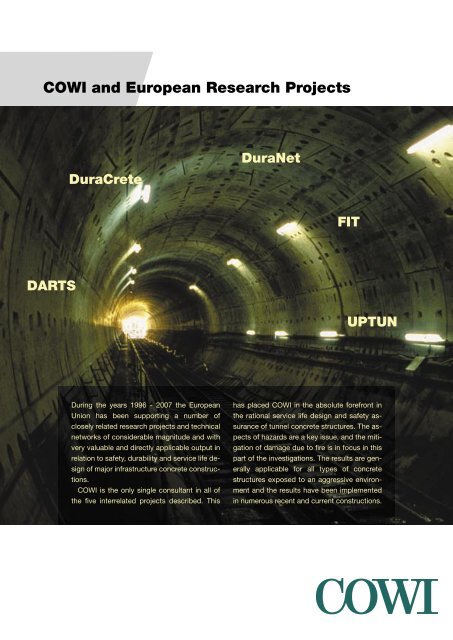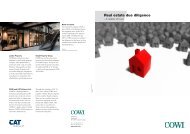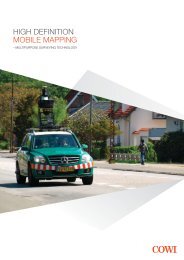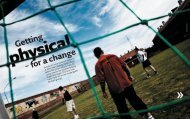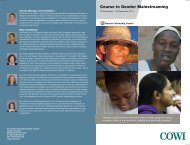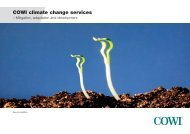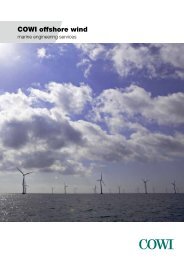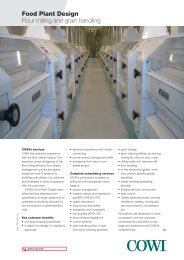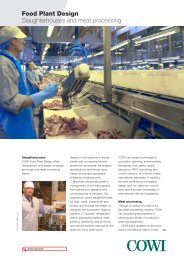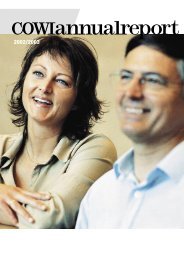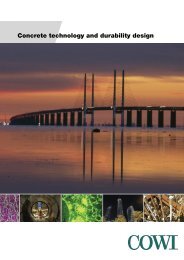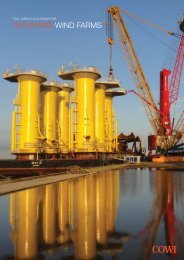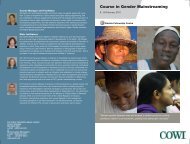COWI and European Research Projects
COWI and European Research Projects
COWI and European Research Projects
You also want an ePaper? Increase the reach of your titles
YUMPU automatically turns print PDFs into web optimized ePapers that Google loves.
<strong>COWI</strong> <strong>and</strong> <strong>European</strong> <strong>Research</strong> <strong>Projects</strong>DuraCreteDuraNetFITDARTSUPTUNDuring the years 1996 - 2007 the <strong>European</strong>Union has been supporting a number ofclosely related research projects <strong>and</strong> technicalnetworks of considerable magnitude <strong>and</strong> withvery valuable <strong>and</strong> directly applicable output inrelation to safety, durability <strong>and</strong> service life designof major infrastructure concrete constructions.<strong>COWI</strong> is the only single consultant in all ofthe five interrelated projects described. Thishas placed <strong>COWI</strong> in the absolute forefront inthe rational service life design <strong>and</strong> safety assuranceof tunnel concrete structures. The aspectsof hazards are a key issue, <strong>and</strong> the mitigationof damage due to fire is in focus in thispart of the investigations. The results are generallyapplicable for all types of concretestructures exposed to an aggressive environment<strong>and</strong> the results have been implementedin numerous recent <strong>and</strong> current constructions.
DuraCrete“Probabilistic Performance BasedDurability Design of ConcreteStructures” (1996 - 1999)(12 partners)The objective of DuraCrete is to useavailable knowledge of concrete deteriorationthrough scientificallybased modelling of the transport<strong>and</strong> deterioration mechanisms governingthe service life performanceof concrete structures. This includesa quantified classification of the aggressivityof different types of environment.Chloride induced <strong>and</strong> carbonationinduced reinforcementcorrosion have been the most advancedmechanisms in the modelling.The project resulted in the publicationof a design guide for servicelife. It adopted the probabilistic approachby introducing the uncertaintiesof the input parameters <strong>and</strong>their distribution functions. Theunique development is that the servicelife design approach is identicalto the well-known method of designingstructures for load, whichthen has been simplified to the socalledload-<strong>and</strong>-resistance-factor-design(LRFD) methodology. In thesame way the DuraCrete approachcan be presented in the frameworkof an LFRD procedure, just for designservice life.DuraCrete has been adopted asservice life design basis for:• The large Dutch Tunnels includingthe world record Green HeartTunnel• The Malmø City Tunnel in Sweden• The world record Sutong cablestayed bridge in China• The Sitra Causeway, Bahrain• The Busan-Geoje Fixed Link with aworld record deep immersed tunnel<strong>and</strong> the bridges• The Subaya Causeway, Kuwait• The tender design of the Qatar-Bahrain Causeway• The tender proposal for the DubaiMetro<strong>COWI</strong> was the key proposer <strong>and</strong> thescientific manager of the DuraCreteproject.Importance ofconcrete coverdesign thickness<strong>and</strong> workmanship. DuraNet“Network for Supporting theDevelopment <strong>and</strong> Application ofPerformance-Based DurabilityDesign <strong>and</strong> Assessment ofConcrete Structures” (1998-2001)(18 partners)The recognised success of the Dura-Crete Project led the <strong>European</strong>Commission to grant support for establishinga special internationalnetwork to disseminate the valuablepossibilities of applying the Dura-Crete service life design methodologieson an international level.DuraNet organised three internationalworkshops with only invitedexperts. The participants were the18 members <strong>and</strong> a small number ofspecially invited experts h<strong>and</strong>pickedin the light of the topic of eachworkshop. The titles, dates <strong>and</strong> venueof the workshops were:• WS-1: “Design of Durability ofConcrete”, which took place inJune 1999 in Berlin, Germany.• WS-2: “Service Life of RepairedConcrete Structures”, which tookplace in June 2000 in Copenhagen,Denmark.• WS-3: “Service Life Design ofConcrete Structures - From Theoryto St<strong>and</strong>ardisation”, whichtook place in June 2001 inTromsø, Norway.
UPTUN“Cost-effective, Sustainable <strong>and</strong>Innovative Upgrading Methods forFire Safety in Existing Tunnels”(2002-2006) (42 partners)The safety systems in a significantpart of the existing tunnels were designedon the basis of traffic <strong>and</strong> itsestimated growth two or more decadesago. It appears, however, thattraffic has grown more significantly<strong>and</strong> also changed in composition(more combustible <strong>and</strong> flammablegoods). Consequently, the safetylevel in existing tunnels has decreasedin cases where no intermediatemeasures were taken to copewith the changed supply of rollingstock. This holds true throughoutEurope, for road, rail <strong>and</strong> masstransittunnels.The UPTUN project main objectsare therefore:• Development of innovative technologieswhere appropriate <strong>and</strong>where relevant <strong>and</strong> the assessmentof existing technologies for tunnelapplication. Focus is on technologiesin the areas of detection <strong>and</strong>monitoring, mitigating measures,influencing human response <strong>and</strong>protection against structural damage.The main output is a set ofinnovative cost-effective technologies.• Development, demonstration <strong>and</strong>promotion of procedures for rationalsafety level evaluation, includingdecision support models<strong>and</strong> knowledge transfer. The mainoutput is a risk-based evaluating<strong>and</strong> upgrading model.<strong>COWI</strong> is member of UPTUN <strong>and</strong>responsible for one key workingparty.
The probability that corrosion will start as afunction of the time after construction for atunnel wall or slab. Relationship shown forthree different concrete mixes.Probability of corrosion0,300,250,20Porous concreteConventional concreteDense concrete0,150,100,0500 20 40 60 80 100Time (years)of exposureDARTSD•A•R•T•S“Durable <strong>and</strong> Reliable TunnelStructures” (2001-2004)(8 partners)The objective of DARTS is to developoperational methods <strong>and</strong> supportingpractical tools for the bestpro-active decision-making processfor choosing, in each individualcase, the cost optimal tunnel type<strong>and</strong> construction procedures.The dominating innovation ofDARTS is the integration of reliability-basedstructural design, geotechnicalissues, service life design basedon the DuraCrete methodology,hazar d design including risk assessment,environmental aspects, societalneeds, sustainability <strong>and</strong> economicaspects.DARTS is developed for the maincurrent types of tunnel constructions:rock tunnels, bored tunnels,NATM tunnels, immersed tunnels,<strong>and</strong> cut <strong>and</strong> cover tunnels.<strong>COWI</strong> was the key proposer <strong>and</strong>the project manager <strong>and</strong> scientificmanager of the DARTS project, <strong>and</strong><strong>COWI</strong> was appointed co-ordinatorbetween DARTS <strong>and</strong> the networkFIT, see overleaf.Feasibility studyDecisionsConceptual designOutline designDetailed designOperation
FIT“Fire in Tunnels” a networkproject (2001-2005)(33 partners)The <strong>European</strong> thematic network onFire in Tunnels (FIT) is a group ofstakeholders focusing on the exchangeof knowledge, integration<strong>and</strong> creation of know-how. FIT hasstrong links with actual <strong>and</strong> future<strong>European</strong> <strong>and</strong> national researchprojects.Increased traffic <strong>and</strong> the trend forlonger tunnels consequently result inhigher risks. Safety, <strong>and</strong> in particularsafety in case of fires in tunnelshave received tremendous attentionfollowing some recent serious fireincidents (Mont-Blanc, Tauern,Channel, Kaprun, Saint-Gotthard).To profit the most from theknowledge throughout Europe,from real fire accidents, testing <strong>and</strong>research, it is an advantage to useall available information via a <strong>European</strong>thematic network.The following main objectives havebeen identified:• dissemination of RTD (<strong>Research</strong>Technical Development) <strong>and</strong> designresults obtained in <strong>European</strong><strong>and</strong> national RTD projects;• to establish a set of consultabledatabases with essential knowledgeon fire in tunnels;• to realise recommendations on firedesign for tunnels;• to develop <strong>European</strong> consensusfor fire safe design on the basis ofexisting national regulation,guidelines, codes of practice <strong>and</strong>safety requirements;• to define best practices for tunnelauthorities <strong>and</strong> fire emergencyservices on prevention <strong>and</strong> training,accident management <strong>and</strong> fireemergency operations.<strong>COWI</strong> is member <strong>and</strong> task forceleader of two tasks.
The futureThe coordinated achievements ofthese 5 projects have identified theneed for a maintained co-ordinationwithin this very essential areaof safety <strong>and</strong> performance.Therefore a new sub-group ITACommittee on Operational Safetyof Underground Facilities has beenestablished under the auspices ofthe International Tunnel Association.<strong>COWI</strong> is a key founding memberof this group.Information:Further information can be uptainedfrom the project web-pages:www.duranetwork.comwww.dartsproject.netwww.etnfit.netwww.uptun.netTorsten MølgaardHead of Department,Tunnels <strong>and</strong> UndergroundStructures+45 4597 2889tm@cowi.comSøren Degn Eskesen<strong>Research</strong> <strong>and</strong>Development Manager+45 4597 2554sde@cowi.comDr. Carola EdvardsenSenior Specialist,Concrete StructuresPerformance+45 4597 2813cle@cowi.comDr. Steen RostamChief Engineer,Concrete DurabilityTechnology+45 4597 2782sro@cowi.comwww.cowi.com<strong>COWI</strong> is a leading northern <strong>European</strong>consulting group. We providestate-of-the-art services within thefields of engineering, environmentalscience <strong>and</strong> economics with dueconsideration for the environment<strong>and</strong> society. <strong>COWI</strong> is a leaderwithin its fields because <strong>COWI</strong>’s3300 employees are leaders withintheirs.<strong>COWI</strong> A/SParallelvej 2DK-2800 Kongens LyngbyDenmarkTel.: +45 45 97 22 11E-mail: cowi@cowi.comInternet: www.cowi.com021-1700-021e-05a


